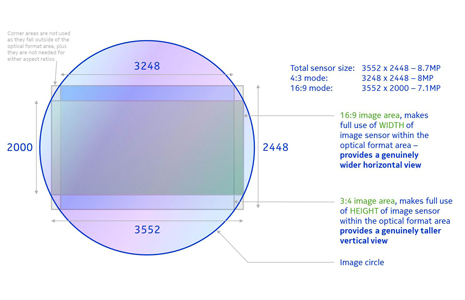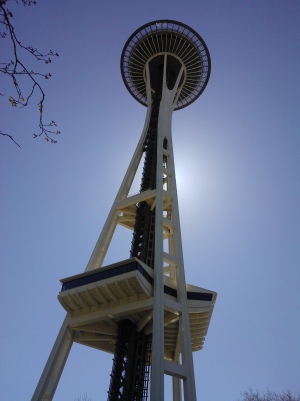Review: Nokia Lumia 900 - Part 2 - Camera and Camcorder in depth
In part 1 of our Lumia 900 coverage, Ewan took a chatty look at the hardware and summarised his feelings about the device - we're now seeing the Lumia 900 appearing in European shops, making it all the more appropriate that we accelerate our review schedule. In this, part 2, I look at the 900's camera capability and its viability for creating and consuming multimedia.
![]()
I suppose I should comment on my own impressions of this latest Windows Phone beast from Nokia - Ewan was dead right when he referred to the Lumia 900 as 'masculine' - it's all straight edges and ridges, all size and weight, compared to the sleeker curves and more traditional phone form factor of the Lumia 800. Neither is necessarily better or worse, per se, but there is a very definite difference in look and feel.
Camera hardware
The Carl Zeiss-lensed 8 megapixel camera in the Lumia 900 is identical to that in the 800, at least in theory, so we know what to expect.
- Although listed as an 8 megapixel camera, the rectangular sensor's actually 8.7 megapixels - 3552 by 2448 pixels, with the optical circle (the image from the lens) overlaid on the sensor area, as shown below. Nokia then takes a 4:3 image at 8 megapixels or a 16:9 image at 7.1 megapixels, as indicated by the shaded rectangles. Most phone cameras just chop the top and bottom off the 4:3 image to get a 16:9 aspect ratio shot, i.e. you lose information, but in this camera Nokia's 16:9 image includes pixels that would be off to the left and right of the full 4:3/8MP version. The bottom line is that the 16:9 widescreen photos end up at 3552 by 1998 pixels, i.e. 7.1 megapixels.
- Much as Nokia would love to have kept the same camera as the N8 (the camera champion from the Symbian world), size constraints were critical for the Lumia 800 and 900 unibody design, especially so as the 900's even thinner than its smaller sister. The restricted height meant that the sensor also had to be smaller, 1/3" optical format, some 70% less surface area than the N8's, and the pixel size had to be reduced to 1.4 microns. To be fair, these statistics match the cameras in the competing Samsung Galaxy S II and Apple iPhone 4S (to name but two) - the laws of physics prohibit a larger camera in such a thin device.
- In order to improve low light photos, a wide aperture of F2.2 was used, meaning shallower depth of field but allowing much more light into the camera. The same aperture figure has recently been used on some competing devices, including the HTC Titan, reviewed here, for much the same reasons.
In other words, the Lumia 800/900 and other top smartphones of today all have cameras that are as good as can be achieved given the need for centimetre device thickness. (The N8, mentioned above, gets away with a larger camera because it's allowed a sizeable camera 'hump' on the back.)
However competent the hardware, taking good photographs also requires sophisticated software these days, and both the different camera interfaces and image processing algorithms play a part in the Lumia 800 and 900 being entirely their own entities in terms of camera and camcorder results. Anecdotally, photos aren't quite as impressive as on the N9, with identical camera hardware, largely because the limitations of the camera drivers in Windows Phone mean performance isn't perfectly optimised yet. A perfect match of Nokia camera technology (sensors, optics and software) and Windows Phone will probably not be possible until version 8 of the OS.
Camera interface
As with the Lumia 800, I loved the way the Lumia 900's camera can be started even if the device is keylocked, by pressing and holding the camera shutter button down, giving the incredible usability of being able to start the Lumia 900 in camera mode within two seconds from a locked state, ready to snap an interesting moment.
The camera interface itself is standard Windows Phone Mango, with on-screen digital zoom buttons and a big settings icon. Tap the latter and you can take your pick from:
- ten predefined 'scenes' (optimised sets of settings) - most people will leave everything on 'Auto'.
- five predefined 'white balance' settings (e.g. 'Incandescent') - again most people will never get this far and will leave this on 'Auto'
- a range of exposure adjustments from +3 to -3 stops in 0.5 increments - useful when shooting into light or trying to create a special effect, if you know what you're doing...
- a range of four ISO settings, from 100 to 800 - best leave these well alone and let the camera software manage shutter speeds unless you're at a music concert or similar and need to grab shots in very dark settings.
- two different 'metering modes' - 'Frame average' and 'Centre spot' - for the camera to work out the best exposure - the default is centre weighted, but if you take a lot of landscapes you might like to change things to full-frame weighted
- four predefined 'effects', all quite basic: Black and White, Sepia, Negative and Solarise. None of which are likely to be used by anyone other than your kids messing around, I suspect
- four contrast levels, from 'Low' to 'Maximum' - best left alone, since you can always tweak contrast later on, on the desktop, if needed
- four saturation levels - again, best left alone, set on 'Normal'
- two focus modes - 'Normal' and 'Macro', with the latter hunting for focus much closer-up, though see the important note below about focussing
- four resolutions: '8MP 4:3', '7MP 16:9', '3MP 4:3' and '2MP 16:9'
- two options for flicker reduction: 60Hz and 50Hz, useful when shooting indoors under artificial lights or when TVs or monitors are involved.
That's a lot to fiddle with, though I was puzzled not to see a 'sharpening' setting too. Having said that, 99.9% of photos taken with the Lumia 900 will be shot by users leaving everything on 'Normal'/'Auto'.
One things stands out as a big problem in the Lumia 900's camera interface though - as focussing happens, there's the usual flashing reticule, to let you know that the software is working. After which - you get a plain white solid reticule. But what does this mean? If a focussing solution has been found, you get this white reticule. If focussing has been a disaster (e.g, because you're shooting something really close up and aren't in 'Macro' mode) then you get... a plain white reticule!
The upshot is that you haven't the faintest idea whether the focus worked out by the phone is any good. At WVGA resolution on the phone screen it's easy enough for all shots to look OK, but if focussing has gone horribly wrong then the first you may know about it is when bringing it up on your large desktop monitor.
This should be easy for Nokia to fix in software, of course - other Windows Phones remove the reticule if a focussing solution isn't found, so I've no idea why Nokia's version of the Camera application behaves differently. Yet, six months after the Lumia 800 was first released, we still have a non-working focussing reticule, and it really isn't good enough.
Sample photos from the Lumia 900
In each case, click on the thumbnail photo to download or enlarge it in your browser, to full 8 or 7 megapixel status:
Two 'typical' indoor snaps in 4:3 mode in reasonable light. Representative of normal user snaps. Pretty good results.
Two typical snaps in sunlight, this time in 16:9 mode. Again, good results, up with those from almost all other camera phones.
Two more challenging photos, both in vertical 16:9 format, the first shooting artistically into the sun and the second more of a macro shot. Good results yet again.
Pushing the envelope further - attempting a super-macro shot (this was the best of 4 attempts - focussing isn't trivial, as demonstrated below); and a shot in artificial lighting (open full size and crop in to see artefacts and digital noise - still, no worse than many other £400+ smartphones)

The focussing reticule problems mentioned above lead to shots like these. Even with the clear Lumia 900 screen, out in the sun you can't really tell whether a shot is focussed or not. The reticule appears, you half press the shutter, the reticule flashes a few times and goes solid, the phone beeps, and.....you haven't necessarily got the focus you wanted. As here. Even though I was within six inches of the dandelion, with its shape largely filling the central reticule, focus was still taken from the background and with nothing on screen to warn me of the fact. Disappointing.
A lot has been made of the possibility of camera phones taking over from traditional standalone cameras, with the likes of Samsung's old Pixon 12 and Nokia's Symbian-running N86 and N8 leading the way. An an ardent fan of the N8 in particular, even I'll admit that almost every photo I've taken with it would have been better to some degree with a decent (>£100) standalone camera. In other words, the N8 gets as close as it's possible to get and yet still ultimately just falls short.
The current crop of 1/3" (as here) and 1/3.2"-sensored camera phones (e.g. iPhone 4S) haven't, therefore, got much of a chance. 70% lower sensor surface area and smaller pixels mean that, even with improvements in sensors themselves (including Back Side Illumination), photos produced from any of these devices are that far further from 'standalone' quality. Which, in itself, isn't a huge problem - it's just important to downplay expectations, whether you have a Lumia 900 or even an iPhone 4S. In each case, take a sunny snap and you'll be quite happy, but results will go downhill to match the sun's arc in the sky.
Night time LED-lit snaps are, predictably, a disaster on all these phones - the slow shutter times and poor illumination mean that it's almost impossible to get a good photo, especially of people, who have a tendency to move!
Video capture
Windows Phone doesn't always get the plaudits it deserves - on the video capture front, each Windows Phone device now has continuous auto-focus and intelligent digital zoom (though the latter didn't work while capture was underway on the test Lumia 900), making it a compelling amateur camcorder, albeit with a maximum resolution of 720p.
Here's a test clip, either watch the embedded YouTube version or grab the 44MB MP4 file and play directly.
The light conditions for this sample were hazy sunshine - I was pleased enough with capture quality once focussed, but a moving/panning phone camera doesn't really give the software time to re-focus properly, which is why some of the panning footage ends up dissatisfyingly blurred. See below for more on auto-focus.
Some competing smartphones now shoot at 1080p resolution, but the single core CPU Windows Phone platform currently maxes out at 720p, still quite high enough for almost all users in my opinion, because:
- The bottleneck in shooting quality is the size and quality of the camera sensor, not the raw resolution. I.e. a video in 1080p isn't necessarily significantly 'better' than the same scene shot in 720p - there will simply be more pixels to represent the noise and low level artefacts.
- At 14Mbps, we're talking of 140MB per minute of footage. So ten minutes of home video would be well over a Gigabyte. With Windows Phones currently non-expandable and limited to 8GB or 16GB, to lose this space to quite a small amount of home-shot video is a real concern. Shooting at 1080p would at least double this requirement, losing two to three Gigabytes for every ten minutes of footage.
- Most people can't (or don't) actually watch phone-shot footage at 1080p. The most common uses of phone video are to watch on a computer monitor or watch on YouTube after uploading - in either case, there's rarely a chance to watch at full 1080p in a way that makes good use of extra resolution.
Interface
The camcorder interface is almost identical to that for still photos, with the addition of on-screen + and - zoom icons (of which more below). Diving into Settings reveals the same choice of:
- a dozen 'Scenes' ('Backlight', 'Beach', 'Candlelight', and so on). Well worth playing with if you have the time, though the ad-hoc nature of phone video means that often you'll simply dive into capture in 'Auto' mode (see the example clip below and also the low-light one).
- five 'White balance' settings, for which the same applies, should you get time to fiddle. To be honest, the distinction between 'scenes' and 'white balance' is somewhat obscure, since some scenes already imply certain lighting conditions - still, plenty to fiddle with!
- 'Exposure' values from +3.0 to -3.0, in 0.5 stop intervals again. Perhaps useful if shooting into light and wanting a certain contrast effect.
- 'Effects', the usual trivial effects that you'll be unlikely to ever need.
- 'Contrast', four settings, best leave this on the default.
- 'Saturation', ditto.
- 'Auto focus', which can be off or on. More on this below.
- 'Resolution', defaulting to VGA, presumably to save users internal disk space, but most people will want to immediately increase this to the full 720p and then 'Save settings'.
- two options for Flicker reduction: 60Hz and 50Hz, useful when shooting indoors under artificial lights or when TVs or monitors are involved.
Intelligent digital zoom
The zoom icons on the camcorder screen aren't token efforts, as on most other mobile platforms. One issue with most phone-shot video in the past has been that the base resolution would be captured (e.g. VGA or 720p) and if the user zoomed in then this VGA or 720p frame would be stretched to produce the zoomed video frames. Nokia pioneered a new approach with its N86 (running Symbian, followed by the N8), where the full sensor resolution would be used at each point in the zoom process, i.e. a new zoomed frame would be derived from the sensor rather than stretching an already downsampled version. I've called this 'intelligent digital zoom' and it typically means that you can zoom up to 3x while seeing full (VGA or) 720p resolution and detail.
The same system seems to have been picked up by Microsoft for Windows Phone and all the WP devices I've tried support the same intelligent digital zoom, albeit with the zoom icons allowing you to go to (roughly) 6x, at which zoom factor there will be some frame stretching involved. See the example in the demo video below. For the end user, all this simply means is that they can safely ignore the usual rule about never using digital zoom. The only real caveat with the Windows Phone implementation is that you can't change the zoom level mid-clip, i.e. you have to stop recording, change zoom level and then start again. Despite this, intelligent digital zoom is well worth noting, even though it's not a unique feature of the Lumia 900 per se.
Note that zooming videos is not mapped to the physical volume keys (as it is on Nokia's Symbian smartphones) - you have to use the on-screen icons.

The Lumia 900 camera. Note the repositioned dual LED flash (compared to the Lumia 800)
and the highly scratchable 'chrome' panel - not the best choice of materials to show off the Carl Zeiss name...
Auto-focus matters
The default setting is to have continuous auto-focus turned on, which is sensible since there's a huge caveat to having it turned off (other than the obvious). Auto-focus itself works by the software varying the lens position until maximum contrast is achieved across the bulk of the viewfinder. This 'in and out' process is often called 'hunting' (as in hunting for focus) and is the familiar short term blurriness and then crispness seen in any camera's auto-focus footage, also evidenced in abundance in the sample footage above.
You won't find auto-focus in any professional video footage because the hunting effect is somewhat ugly, but for casual users (who generally haven't a clue about light, focus and subject distance) it's probably the best bet, since the software will try and do its best in all circumstances. The hunting operation takes around a couple of seconds and is kicked off whenever the Lumia's camera detects that enough of the subject has changed in the viewfinder.
The accuracy of auto-focus is affected adversely by light levels, as you might expect - too dark and focussing will be harder and take longer. It's also worth noting that it's not just the very centre of the viewfinder that is monitored for contrast, so you can arrive at a position where you have a small object in the foreground that's out of focus and a larger subject just behind it that is in focus. As ever, the more of a handle you have on what you're doing in terms of framing and composition, and the steadier you keep the Lumia 900, the more likely the chances of good video capture.
If you really want to avoid the effects of auto-focus hunting and have a subject of constant distance then it's possible to flick auto-focus off in the settings. However, the lens gets used in the last position it was left by the continuous auto-focus, which means that you need to plan ahead slightly and auto-focus on the same (or a similar) subject prior to switching auto-focus off. With care, though, you can get good results this way.
Audio capture
Good audio is just as important as good video, of course. On the Lumia 900 (as for the 800 before it), it's clear enough without really impressing. Very loud noises (e.g. at a live music event) cause fairly horrible distortion, but casual use around family and friends will be fine.
Form factor implications
One downside of the smooth polycarbonate used in the Lumia 800 and 900 is that the phones are each rather slippery in the hand. The 800 comes with a tough rubber sheath and I make sure it lives in this - it's ten times harder to drop accidentally. However, the Lumia 900 is both larger and thinner, and doesn't come with a similar case, making it more prone to clumsy accidents. The use of a proper shutter button does help, in that you're encouraged to brace the phone using a full four fingers/thumbs, but I still worried when photographing using the Lumia 900 near water or over a drop of any distance. I'd recommend new users invest in a 'sheath' style case for both photography and more general smartphone use.
Sharing captured video
When you plug the Lumia 900 into a Windows PC, as with any other Windows Phone, Zune Desktop automatically copies across all captured videos (and photos) if configured that way: on the Mac, the free Windows Phone 7 Connector utility does much the same, adding a trick by also importing anything new into iPhoto. From both imports, you can drag into a video editor as needed or simply upload to YouTube on the desktop.
More potentially interesting is the totally mobile solution. Having taken a video, tap on the three 'dots' that constitute a shortcut and you'll see two sharing options. 'Share on Hotmail', whereupon the video is compressed and transcoded again to tiny size, for attaching to an email; and 'Share on SkyDrive', whereupon your original MP4 video file gets uploaded to your space in the Cloud. At least this last option preserves the full resolution of your video and the uploading works smoothly in the background, though the SkyDrive site is slow at delivering your video online, for later playback on another screen.
Blindingly obvious here is that there's no YouTube upload facility (let alone Vimeo or other video hosts). Yes, Google now owns YouTube and Google is Microsoft's arch rival, but YouTube is by far the dominant video host online and I can only assume that 'Share on YouTube' is another of those Windows Phone functions which hasn't been written yet. Let's hope it doesn't take until Windows Phone 8 (or similar) for YouTube integration to arrive.
Verdict
The Lumia 800/900's camera certainly doesn't disgrace itself - I'd rank it just below that in the bestselling Samsung Galaxy S II and certainly below that in the Apple iPhone 4S (not to mention the Nokia N8, which is in another league), which at least is good company.
Video recording, though limited to 720p, is generally pretty good. In skillful hands, aware of light conditions and waiting for auto-focus to lock onto each panned subject, results can be excellent in good light.
Indoors and in low light, both stills and video degrade in line with other competing smartphones, as you might expect. The benchmark here will be Nokia's own 808 PureView, with giant 1/1.2" sensor and running Symbian, due out imminently in the shops - Nokia has strongly hinted that this same technology and camera capability will come to Windows Phone in the near future, so place your bets now for the appearance of a Lumia 950, or similar, at a future Nokia event.
In part 3 of the Lumia 900 review, we'll look at its application set, including multimedia credentials.
See Also
Nokia Lumia 900 Gallery (image tour)
Review: Nokia Lumia 900 - Part 1 - Design and Hardware
Reviewed by Steve Litchfield at









